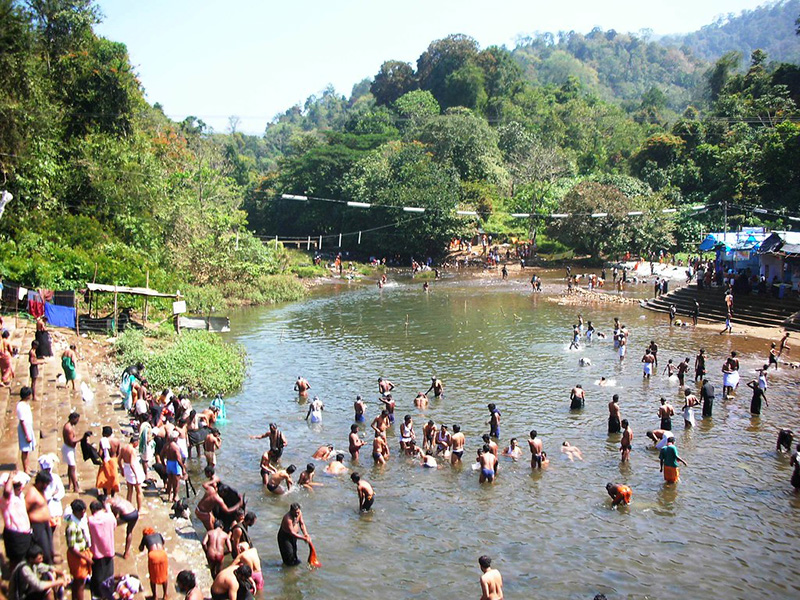The Holy Trek
Erumeli—The Gateway
Nov 2014

There are many routes to the Temple, but the one via Erumeli is the most arduous and the longest. This is the route prescribed by the Lord and obviously, therefore, it is considered sacred. The Lord, it is said, trod this path when he went in search of leopard’s milk. The distance from Erumeli to the precints of the temple is about 45 miles. Erumeli is the vehicular terminus where pilgrims from all places gather by public and private conveyance. Imagine for a moment a small village, the last outpost of civilization, with a normal population of a thousand or two, suddenly swelling to a floating population of three or four lacs, all pilgrims and pilgrim traders clad in black, blue or ochre. Everywhere the name of the Lord rends the air.
In Erumeli there is also a temple of Vavara, a Muslim devotee of the Lord. The story goes that Vavara became a devotee of the Lord after a fierce fight between the two, and that the Lord then made him His first lieutenant. Hindus and Muslims join in worshipping in the temple of Vavara, a symbol of Hindu-Muslim unity. That for the uplift of mankind in the land of Bharata, Hindu-Muslim unity was preached and sought to be brought into practice in the South even in those very early days needs no further proof than this one place where even today we see the two religions meet and join in worship.
The idol of the Lord in Erumeli temple is in the form of a hunter, and it is here that first-timers (in Sabari Hill called “Kannis”) perform “Petta Thullal”. That is to say, their whole body is smeared with different colours, making them look rather ridiculous and they start in procession from the temple of Karuppuswami, a lieutenant of the Lord, to the temple of the Lord, dancing rhythmically to the sound of the drums
“Swami Thinthakathom, Ayyappa Thinthakathom”.This is believed to be the return of the hunter with his booty after a day’s hunt.
For a modern man of the so-called cultured and educated classes, to dance in public to the tune of the wild drums, and that too with his whole body smeared in different colours, and with a jungle rod over his shoulders decorated with leaves and vegetables, may appear revolting. This is the first acid test as to whether one values oneself above others or considers oneself one with them. The ego receives a blow here. The Lord desires us to surrender to Him to the uttermost. He desires our purified mind, not our body.
After Petta Thullal the pilgrims go in their groups, clad in clean clothes, to the temple of Lord Dharma Sasta and offer prayers for his permission to tread the Sacred Hills, after which they leave the place.
From Erumeli they set out barefoot on their arduous journey through the jungle. The first stage of the journey is about 3 or 4 miles and terminates at a small canal called Perur Thodu. Those who leave Erumeli towards evening reach Perur Thodu by dusk and camp there for the night. Some distance beyond Erumeli the pilgrims come on to a small country road, leading towards the deep jungle. The whole place is green meadow dotted with small hutments, dwellings of the workers of the nearby plantations.
Rising early the next morning, the pilgrims say the usual prayers and then start on their trek from Perur Thodu. The track here is lined with bushes on both sides, with occasional tall trees, the watch-towers of nature. It is a pleasant sight to watch the rising sun in these parts, to feel the chilly breeze blowing and hear the welcoming sounds of the birds. But as the sun climbs higher and gets hot, progress becomes difficult. For in these parts there are no shady trees along the track to give shelter from the burning sun. There is not even a good path. The pilgrims simply have to follow the dried up water courses encumbered with boulders, bushes and low-growing forest vegetation. There are occasional tracks of wild beasts at the thought of meeting which men shudder. The tired pilgrims at last reach the banks of the river Alasa, popularly called “Azhutta”, after about a six miles walk. The epic says that the Lord threw down Mahishi from Devaloka on the banks of this river and performed his Cosmic Dance over her body, thereby redeeming her from Datta’s curse. Even today the Kannis, while climbing Azhutta mountain, throw a small pebble at the place where the mortal remains of Mahishi were dumped, to commemorate the victory of good over evil.
